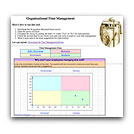
~ Lazarus Long

Prepared for EDTEC 685, Informational & Instructional Technologies for Organizations, Fall 2006. This project is a web site integrated with an excel spreadsheet.
This project is a web site integrated with an excel spreadsheet.
Analyze, synthesize, use inductive and deductive reasoning, solve problems effectively and creatively.
We were assigned to groups building solutions to various topics that are critical to organizational success, such as recidivism and communications skills. I worked with Kacy Whittenburg on our topic of Time Management. Kacy and I balanced the work load evenly, each doing research, then branching out into different technical areas. While Kacy developed the function of the spreadsheet, I built the web site. We both contributed to the questions, color scheme, and solution system.
The Cognitive standard requires a demonstration of the ability to analyze, synthesize, and use inductive and deductive reasoning to solve problems effectively and creatively. Very early in the process we decided to concentrate our efforts on helping organizations improve their time management. To address this problem, we realized that most organizations leave it to individuals to manage their own time effectively, but don’t often look at the underlying drivers that limit a team’s time management effectiveness.
We set out to develop an analysis tool based on the four performance drivers of skills/knowledge, incentives, environment, and motivation. For each driver, we developed five diagnostic questions, each directed at the small group supervisor. As a supervisor answers the questions in our spreadsheet, a diagram displays the aggregate of the responses in their appropriate quadrants. The spreadsheet synthesizes the responses so a supervisor can then see immediately the largest “trouble area”. From that area, a live link takes them to a web page tailored to provide solutions specific to that performance driver.
For example, answering YES to the question “Is the work space organized to allow good use of time?” puts a mark in the ENVIRONMENTAL DRIVERS quadrant, which links to a possible solutions such as “Arrange task work stations in the same area that employees spend most of their work time.” The process uses inductive reasoning to isolate the most important driver, then use deductive reasoning to offer specific solutions for that driver. Our tool helps organizations solve their time management performance problems through a quick interview process that provides tailored solutions based on their responses.
We reached a conceptual breakthrough when we realized practically all the literature addressed individual time management solutions, but there were practically no solutions for organizations. Organizations can't really manage time, but they can manage events. This realization enabled us to make the leap beyond time management as a process to time management as a performance problem. At that point, we were able to start a classic performance analysis as outlined in Mager & Pipe’s Analyzing Performance Problems.
We were also determined to present the problem in an appealing way, that engaged the learner visually as well as cognitively. Our efforts were driven to make the experience very "CLAM-y" (Contextually Authentic, Learner Centered, Attention Riveting, and Message Extending). We asked questions germane to the work environment, concentrated on our target audience, coordinated web and spreadsheet colors between the four drivers, incorporated the same iconic graphics into our web, print, and powerpoint materials, and distributed a message-extending "EDTEC TUIT" pin with our tool's URL.
I have long known that I’m a synthesist. I see trends in supposedly unrelated data points. In this way, I’ve often served in the role as instructor, explainer, or pathfinder for others. By developing this tool, I have effectively transferred some of my inductive ability to a technological tool. The tool can now continue my work without my direct intervention.
Building this tool reinforced the power of a good performance analysis. By looking at the four drivers, you can almost instantly achieve a clear view of many problems. I’ve learned to reach for the performance analysis early in my thinking, and how to wield it effectively to achieve lasting results.
Mager, R. & Pipe, P. (1983). Analyzing performance problems (3rd ed.) Atlanta, GA: CEP Press.
Rossett, A. (2006). Learning with clam: a tour of high value strategies. Retrieved
November 23, 2006, from http://edweb.sdsu.edu/Courses/ED795A/